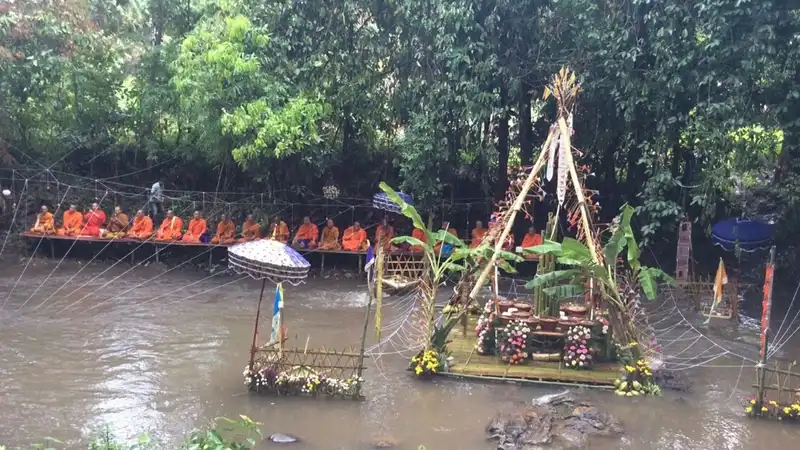The Water Spirit Ceremony Thai Culture

Rating: 5/5 (1 votes)
Chiang Mai attractions
Attractions in Thailand
The Water Spirit Ceremony Thai Culture and Tradition The Water Spirit Ceremony, or "Sueb Chata Mae Nam," is a significant and unique tradition in Thai culture, reflecting a profound connection between humans and water. Particularly in communities situated along rivers or sacred water sources, this ceremony not only demonstrates respect for the river but also preserves longstanding beliefs and traditions. It plays a crucial role in promoting prosperity and community development.
Meaning and Importance of the Water Spirit Ceremony The Water Spirit Ceremony is an act of reverence and worship toward rivers, which are considered sacred in Thai culture. Thai people believe that rivers are sources of life and abundance. The purpose of the ceremony is to pray for the prosperity, safety, and well-being of the river and the community, as well as to express gratitude for the benefits provided by the river. This ceremony also helps strengthen community bonds and relationships.
Characteristics and Steps of the Water Spirit Ceremony The Water Spirit Ceremony is usually held during significant times, such as the beginning of the year or during water-related festivals like Songkran or Loy Krathong. The ceremony takes place at rivers, canals, or sacred ponds that hold religious or historical significance for the community.
Steps of the Ceremony
Preparation: Villagers prepare various offerings, including sticky rice cakes, fruits, flowers, incense, candles, and flags, to present at the ceremony site. The area along the river is often beautifully decorated to create a fitting environment for the event.
Conducting the Ceremony:
Opening Ritual: The ceremony begins with chanting and prayers to ensure that the event proceeds smoothly.
Offering Ritual: Villagers present sticky rice cakes, fruits, flowers, and incense at designated spots, while chanting prayers for the prosperity of the river and the community.
Chanting and Merit-Making: Prayers and merit-making rituals are performed to bless the river and the community with auspiciousness.
Releasing Krathongs or Flags: After the offering ritual, villagers release krathongs (floating offerings) or flags into the water as a symbol of sending good fortune and blessings to the river and the environment.
Celebration: The ceremony often includes various activities such as musical performances, traditional games, and local food to create a festive atmosphere and foster community unity.
Today, the Water Spirit Ceremony continues to be preserved and celebrated in many regions of Thailand. However, it has adapted to modern societal changes:
Environmentally Friendly Materials: There is an increased use of environmentally friendly materials for making krathongs, such as natural or biodegradable materials, to reduce environmental impact.
Enhanced Activities and Displays: Modern ceremonies often feature a variety of activities and performances to attract tourists and generate interest in the tradition.
Tourism Promotion: The Water Spirit Ceremony is increasingly promoted as a cultural tourism event to introduce Thai culture to both domestic and international visitors. This includes exhibitions and activities that allow participants to learn about and experience the tradition.
The Water Spirit Ceremony is an important cultural heritage of Thailand, reflecting deep-seated beliefs and the relationship between humans and nature. Preserving and promoting this tradition not only maintains cultural heritage but also enhances community cohesion and well-being. Ensuring that the ceremony remains relevant and recognized in the future is crucial for allowing future generations to learn about and take pride in their cultural heritage.
Comment
| Keyword (Advance) |
 Region
Region
|







 Category:
Category:  Group:
Group: